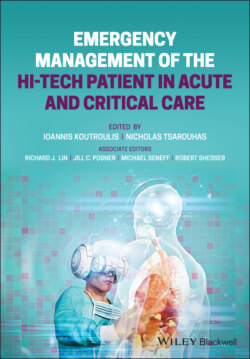Читать книгу Emergency Management of the Hi-Tech Patient in Acute and Critical Care - Группа авторов - Страница 34
Clogged Tubing
ОглавлениеA clogged feeding tube is one of the most common causes for enteric feeding device malfunction. Residue from medications and formula build up over time and ultimately can lead to complete occlusion of the tube lumen. Resins and bulking agents are contraindicated through any enteric feeding device as they both can lead to obstruction of the tubing. Likewise, all medications and formula administrations should be followed by a 20 ml flush to prevent blockage.
The management of a clogged feeding tube depends on the type of tubing. An NG or OG tube should simply be replaced. Likewise, a G‐tube in a well‐healed tract with no trauma should also be replaced if simple declogging measures do not remove the obstruction. Every effort should be made to release the obstruction for GJ and NJ tubes, as the placement of both of these requires fluoroscopic guidance.
Most feeding tube obstructions can be flushed with a 60 ml syringe. First, try pumping air into the tubing to break apart the clot. If that does not work, the best irrigant is warm water. Carbonated beverages and colas have been studied and are inferior. Finally, if warm water does not remove the obstruction, then a mixture of pancreatic enzymes dissolved in a bicarbonate solution can be used. The mixture is left in the feeding tubing for two to three minutes, and then flushed through with warm water. One option is to mix a pancrelipase tablet with 650 mg of bicarbonate in 10 ml of water. If neither of these treatments is successful, a contrast‐enhanced radiograph should be ordered to confirm tube placement, and alternative diagnoses such as buried bumper or G‐tube displacement should be considered.
